The farmhouse in Nuoro was old and the wind-whipped olive trees were old. The wine bottles on the old windowsill were old, and the cat lounging below was not old but the dust on his coat was. The fading afternoon light made the hills an old orange, a hue that conveyed centuries, one generation after the next walking the same little road to the same little school, boiling pasta at the same fireplace, discussing their days at the same old dinner table. Soon the farmer who lived here was bringing me salami at one of those old tables.
Nothing changes on this part of the island. Now that’s changing, the farmer said.
He was little and old, a too-small baseball hat balanced improbably atop his head. His farm had been in his family since forever. A fading fire snapped beside me. He kept running out of the kitchen to see how I liked his charcuterie or to tell me something urgent about Sardinia.

Sardinia received around 9,000 arrivals in 2016.
Photo by Alex Cretey Systermans
The Sardinia encountered by most outsiders is beach Sardinia: 1,200 miles of white sand and sparkly grottoes and Listerine-colored sea lapping mellowly at pristine coastline. But drive inland a couple hours and it’s another world—an older one. Here in the rugged center, tiny villages tuck into shadows of wild, rocky mountains. So forbidding is the interior that the ancient Romans, who conquered everything they ever saw, shrugged and walked away. The shepherds and hunters and bandits remained, tending sheep and generally flying under the radar of the outside world. A dollop of impenetrability plus a vast moat have a way of buffering you from time itself. Picture a Mediterranean paradise preserved in amber.
But even amber melts in time, the farmer was saying. The big religious festival that comes to town every spring and fall, for instance. It sweeps into the local church, a whitewashed building on a promontory surrounded by a ring of small outbuildings. Historically, those outbuildings were reserved for the pilgrims who arrive for the festival, but lately there had been a push to let other people live there year-round. The farmer was worked up about this, but I couldn’t tell why. Were these people messing up the buildings? I asked. He shook his head. It was something else. These people are . . . travelers. They’re . . . not from here.
Picture that pretty Listerine sea again, but now with a raft on it, and in that raft 100 terrified men and women and children.
Since the general destabilization that followed the Arab Spring of 2011, more than 4 million refugees (who are fleeing conflict or persecution) and economic migrants (who are seeking a better life), many from Africa and the Middle East, have entered the European Union. Some 600,000 have crossed from Libya to Italy since 2014. Mostly they’ve ended up in more familiar migrant destinations, like Lampedusa or Sicily. But as those places have hit capacity in recent years, the wider world has at last begun washing up on Sardinia’s shores.
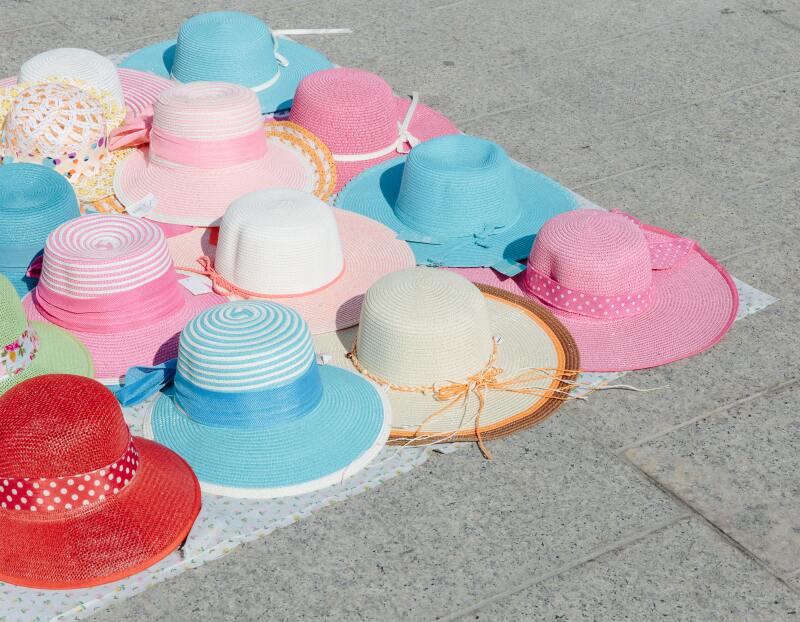
Kitschy sun hats lay out for sale on the streets.
Alex Cretey Systermans
Sardinia received around 9,000 arrivals in 2016 (almost double what it had taken in the year before), and while that represented a scant 3 percent of the total Italy as a whole absorbed in that time, it’s not an insignificant number for an island of less than 2 million people. (Ask the farmer in Nuoro.) In Cagliari, Sardinia’s capital, migrants and refugees are for the first time a visible if marginal part of the city. They sell handbags at the municipal beach and hawk goods outside the cafés and shops that line the city’s narrow streets, their folding tables stacked with Sardinia pins, Sardinia hats, Sardinia shot glasses, and other celebrations of a place they’d had no intention of calling home.
Massive migrations are happening all over the planet, of course. But in the last year I’d grown extra curious about what that looks like in a place so untouched by change, historically speaking. Wander into the right village in Sardinia and you can still hear Sardu, the indigenous language, spoken. Idiosyncratic culinary traditions remain, unhomogenized by modernity. On the same trip when I met the farmer in Nuoro, I ate a pasta made nowhere on Earth but for one little hill town here. The famed longevity of the island’s residents—Sardinia has the world’s highest concentration of centenarian men—may have something to do with their geographic and genetic isolation. You can actually take a tour bus to where the old people live and crane your neck for a glimpse of Sardinian ancientness.
At a deep psychic level, of course, xenophobia makes a certain sense. Repelling outsiders is in the island’s bones.
Against this backdrop a small but profound metamorphosis was playing out, and it’s this metamorphosis I had returned to the island to see. I arrived in Cagliari toward the end of summer. The last of the German tourists were squeezing in their final octopus salads at wobbly outdoor tables, and soon the autumn rains would begin. For now the streets were warm, the surrounding ocean jewel-like. My apartment was down by the harbor. Watch long enough and you’d see the cruise ships coming in and the rescue boats going out.
My first morning, I set out from my apartment heading north through the old town. I walked past chipped buildings hung with vines to meet a local woman named Ornella D’Agostino.
She and I had been in touch before my arrival, and on my first day in Cagliari, we agreed to meet at the Teatro Massimo. A director and choreographer by training, she’d become aware of the refugee crisis here in the Mediterranean years back—aware, specifically, of how little she understood. When these men and women started to land on Sardinia’s shores, she found herself fixating on their internal experience.
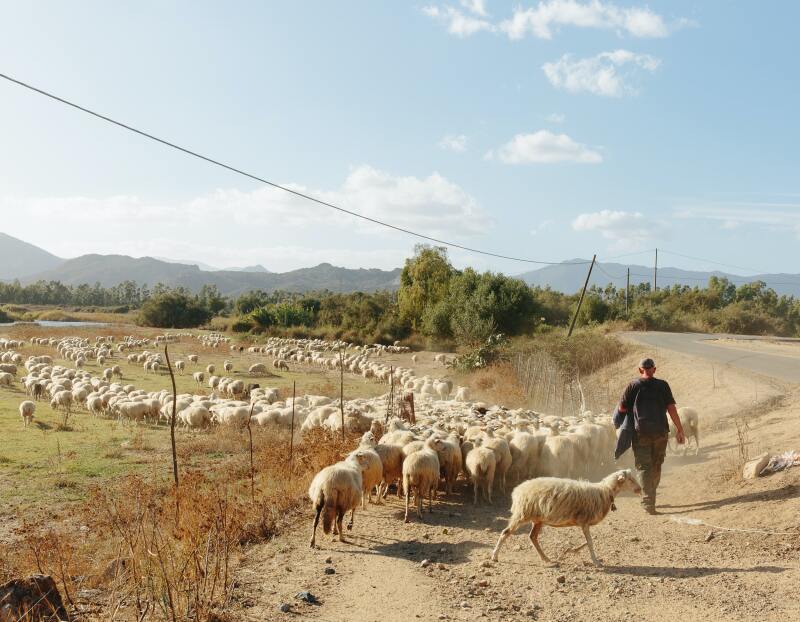
A herder corrals sheep in the rural areas of southwest Sardinia.
Photo by Alex Cretey Systermans
“They arrive after a huge trauma, but they don’t allow themselves to have feelings or desires. They arrive with the idea they have to work, to send money back to Africa, and that’s all,” she’d told me over the phone.
The Massimo was stylish and modern, all polished wood and soft lighting. I wandered around until I spotted a tall, serious woman striding around a broad stage; a group of dancers and musicians listened, nodding.
D’Agostino is in her late 50s, with the gray gravitas of Jane Goodall and the erect poise of a dancer. She’s serious about art—not just about hers but about anyone’s. Looking at the population of people crossing the sea, she sees not just a tragedy in broad strokes but also a specific one rarely mentioned: She can’t help but think of the marooned artistic souls who surely make up a segment of that community. “They don’t allow themselves to identify as artists, don’t get to express all these important experiences,” she told me now, over in the wings. She considered it existentially impoverishing for the migrant community and for the island they’d come to call home.
In 2016 D’Agostino began putting together a theatrical production in which all the performers were migrants and refugees. After months of rehearsals, the men and women on the stage in front of me were putting on a show. In two days the curtains would open to a depiction of refugees as something other than needy wretches in crisis. There would be a show in the capital, and then they’d go on tour elsewhere on the island. The island, in turn, would present itself as a place that makes room for something new.
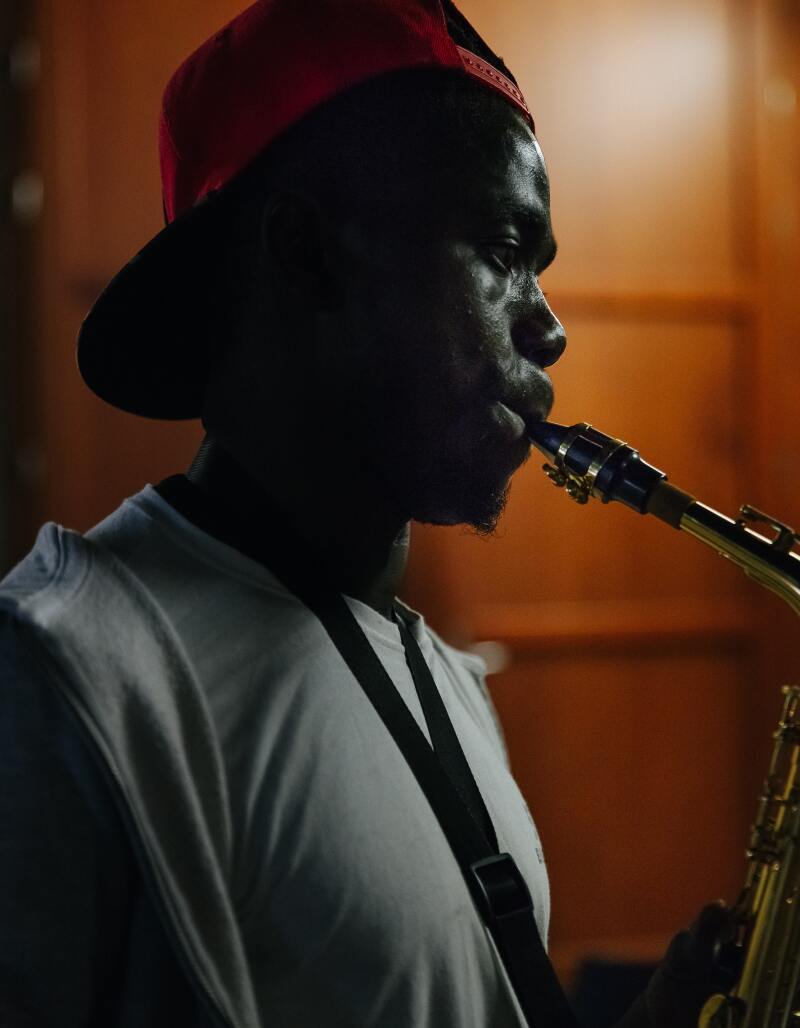
A journey that began in Gambia led Omar Baldeh to Sardinia.
Photo by Alex Cretey Systermans
Later that day I told my wife about the show being planned.
“What’s it about?” she asked. I quoted D’Agostino: “It’s a ‘dance/music/live music/speaking/creating situation.’”
“What does that mean?”
“No idea.”
D’Agostino introduced me to one of the performers, a young man named Omar Baldeh. He had come over from Gambia nearly a year earlier. We fell into conversation immediately.
Baldeh had discovered the trumpet as a kid, or it discovered him. Baldeh’s village was small, fellow musicians scarce. He played whenever he could, joined a ska band in high school. When he started jamming with a group of Christians—which is to say non-Muslims—his father was furious. There was a fight; it got ugly. Baldeh hit the road, crossing into Senegal, then Mali, then Burkina Faso, then Niger, until bad luck deposited him in Libya.
Like many Africans who end up in Libya, Baldeh discovered that the war-torn land isn’t a nation so much as a giant trap, one in which outsiders are arrested to be fleeced, then let go, then fleeced again. They locked Baldeh up immediately, pressed him for any money he could rustle up. He had none.
“Migrants are just a commodity there,” he said. “They are nothing. I thought, ‘I will die here.’”
Baldeh is 19, with a young guy’s short, spiky dreads, but his face got the faraway look of an older man when speaking of his time in detention. When at last he was given an opportunity to buy his way out with manual labor, he leapt. Libya is hell, he told me quietly.
Released, he made a beeline for the coast, hiding in the trunks of cars, disguising himself as a woman at times. In Tripoli a human trafficker threw him some work in exchange for a spot in that raft bound for Italy.

Migrants and refugees rehearse at Teatro Massimo.
Photo by Alex Cretey Systermans
It was around midnight on a dark beach in Libya when Baldeh joined 124 men, women, and children squeezed into a cheap rubber raft. The 40-horsepower motor was suited for puttering, the emergency phone given to them by the smuggler just a toy, they’d learn. Everyone knew of the thousands who drown each year attempting this very crossing, but there was no turning back. Baldeh straddled an edge, one leg in the boat and one in the water.
In the hours that followed, their boat would rise and fall on massive waves. The engine died. The wind howled. Baldeh did an impression of that howl—WEEOOOO—that itself was somehow terrifying. The trafficker had assured them the Europeans would pluck them from the water within two hours; indeed, Italy expanded its efforts to rendezvous with migrant vessels after a spate of high-profile mass drownings. Seven hours had passed. At last dawn came, and with it the approach of a rescue boat.
Safely hauled aboard, someone asked at some point where they were going. Would it be Lampedusa? Sicily?
“Sardinia,” the captain answered. The response that rippled through the weary group: “What’s Sardinia?”
What does it mean when a place starts to absorb the stories of people like Baldeh? How does that shape the place? I was walking around, chewing on these questions. And then, because there’s a lot of walking to be done in Cagliari, I chewed on travel itself. As travelers we tend to treat our destinations as fixed entities. We speak of them as constants: static places to be experienced whenever our vacation days line up right. Have you been to Sardinia? The question implicitly asks if you’ve encountered what’s been there for ages. If you ate the traditional flatbread, if you snorkeled at the beach where Aunt Rose snorkeled back in the ’80s.
But this view distorts. Places—interesting places anyway—are forever mutating. We see this when we walk through a history museum and realize we’re no longer wearing togas. But isn’t history just current stuff that got old? What if we could catch those mutations in real time?
So I tried, striking up conversations with migrants, and officials who worked with migrants, and native Sardinians. On a beach outside town I met Mauro.

Colorful homes line the streets of Sardinia.
Photo by Alex Cretey Systermans
It was a hot, windy morning and I’d decided to take a day trip to the small seaside town of Porto Pino. My translator drove. The city gave way to countryside and sheep and jagged hills and scraggly trees. A castle loomed in the distance at one point. “That was in Dante’s Inferno,” my translator mentioned casually, like we’d spotted an actor from Law & Order. A half hour later we were on the beach.
We had not been there long before this fellow Mauro walked by and started chatting. He had a dignified air—white hair, trim Walt Disney mustache—and had worked as a geologist at a nearby mine until it closed. We made small talk awhile but couldn’t avoid the elephant in the room.
Thirty feet over Mauro’s left shoulder was a large wooden skiff partially buried in the sand. At first glance I took it for a prop, a bit of nautical color the tourist board had installed for Instagram purposes. In fact the nautical color had been installed by Mediterranean currents and luck a week earlier. Porto Pino is one of the loveliest powdery beaches in southern Sardinia. It’s also the closest bit of Europe from the Algerian city of Annaba. Mauro had watched from his home nearby as the skiff’s occupants had disembarked in their newly adopted homeland. The sight hadn’t sat entirely well with him.
I kept seeing signs of bending. I heard stories of small-town, job-poor Sardinians who nonetheless welcomed the new arrivals.
“I’m not racist,” he told me. “But I watch them take selfies before the carabinieri pick them up. They don’t have iPhone X. They have iPhone 20.”
He went on in a familiar vein: If they need our help so badly, why do they have fancy phones? Why are they so concerned with snapping photos at what should be a somber moment?
I try to keep my counsel when traveling, but I couldn’t help myself. They’ve just left behind everything they’ve ever known, I said, for a boat ride that could easily have killed them. Of course they’re on their phones, they’re calling their mothers.
The next day, back in Cagliari, I hiked through town, up and up the winding little streets until I was at the top of the medieval fortress that looms over the old city. I stood there awhile, looking out over the winding alleys and the bay and the ocean beyond. It was impossible not to see Sardinia for what it is: a speck. It is surrounded by sea and whatever threats that sea may bear: invading Phoenicians, the Crown of Aragon, the French army landing right there on Poetto Beach during the Napoleonic wars. At a deep psychic level, of course, xenophobia makes a certain sense. Repelling outsiders is in the island’s bones.
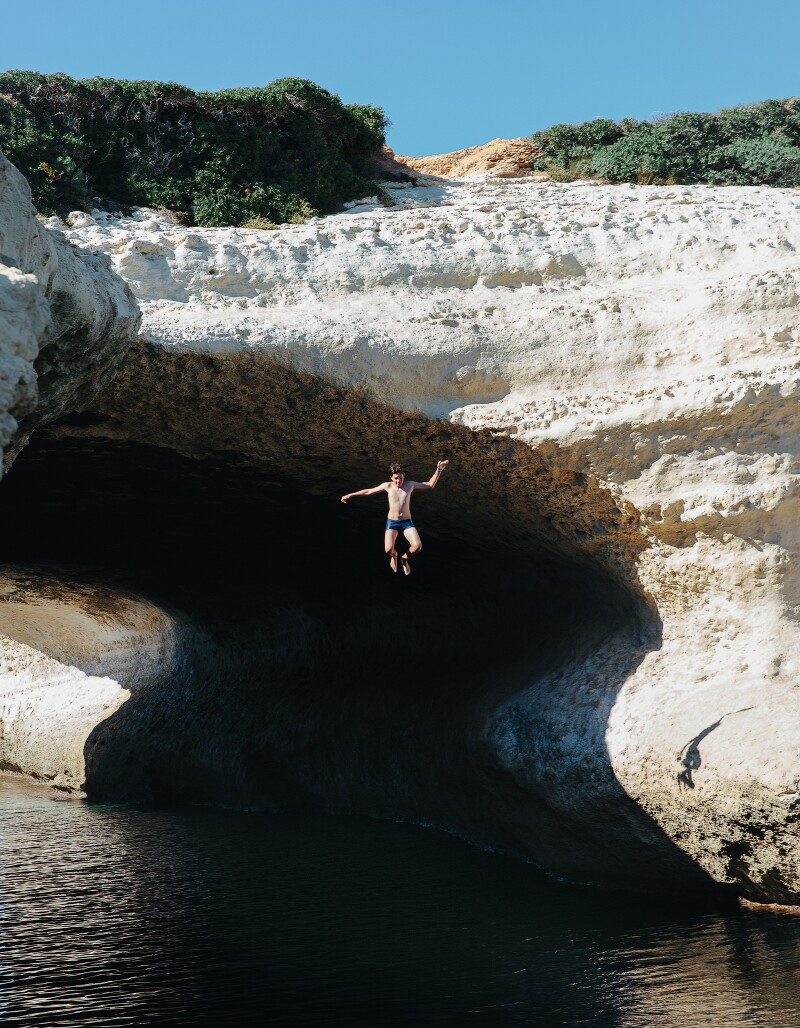
The large Italian island is famous for its rugged landscapes surrounded by warm Mediterranean waters.
Photo by Alex Cretey Systermans
But letting them in is also in its bones. Influences of those same invaders swirl through the food and the art and the architecture here. As is true anywhere, the liveliest bits are the muddiest, this culture blending with that. As always, it’s the locals who must decide whether to stiffen or bend.
Maybe this is naive, but I kept seeing signs of bending. I heard stories of small-town, job-poor Sardinians who nonetheless welcomed the new arrivals. They cited the Pope; we have to help, they’d say. In other cases the migrants have brought tangible benefits—say, increasing a town’s population enough to lure a doctor to that region. One rural village, contending with an aging population, was set to shutter its only school. Only 16 kids lived there and the school needed 20 to operate. Then four African children were settled in the village, and voilà, the school stayed open.
One afternoon I walked to the Piazza del Carmine, a tucked-away square lined with thick trees. Rising from the center is a statue of the Madonna herself, robes flowing, arms outstretched benevolently. The real benevolence here is the free Wi-Fi. It’s what draws migrants and refugees from all around the city, a mini UN occupying every available bench.
“Nobody knows their destination,” he told me. “So this is home.”
“The Gambia guys sit here, the Senegal guys sit there, the Guinea guys sit there, the Nigeria guys sit there . . . ,” a young man explained to me. He was a Gambia guy. The scarcity of work and the sheer loneliness of living in a new place—many of the migrants here have been placed outside the city, in an array of small towns—make a central meeting place extra appealing. “It’s the place for everyone to socialize,” he said.
I made the rounds, chatting with a dapper fellow in a starched white suit, a Nigerian woman with a puffy coat zipped to her chin, and a tall guy who had found a job at a fancy restaurant. The piazza had a convivial vibe, excited conversations in assorted tongues, phones passed around for chats with friends and family back home. But apprehension hummed below the surface. Everyone asked, shyly, that I not use their names or take photos. They’d arrived safely, and the horrors of their journey were behind them, but a broader uncertainty remained and might forever.
They hadn’t intended to be here. Many asked the same questions upon reaching Sardinia: Where’s the train to Paris? Where’s the train to Berlin? When they learned they were on an island nearly 1,000 miles from those places, the news was crushing. But often, then, a shift happened. The weather reminded them of home. The Sardinians turned out to be friendly, by and large.
Baldeh, the Gambian musician, had arrived to find a place astonishingly different from all he had known. His first week there, the sight of women without veils shocked him. So did seeing boys and girls kiss in public. So did seeing a place where whites are the majority. Even the way people moved and walked seemed strange. But the strangeness gradually faded, replaced by something more like a philosophy. “Nobody knows their destination,” he told me. “I want to make music, and people are willing to help me here. So this is home.”
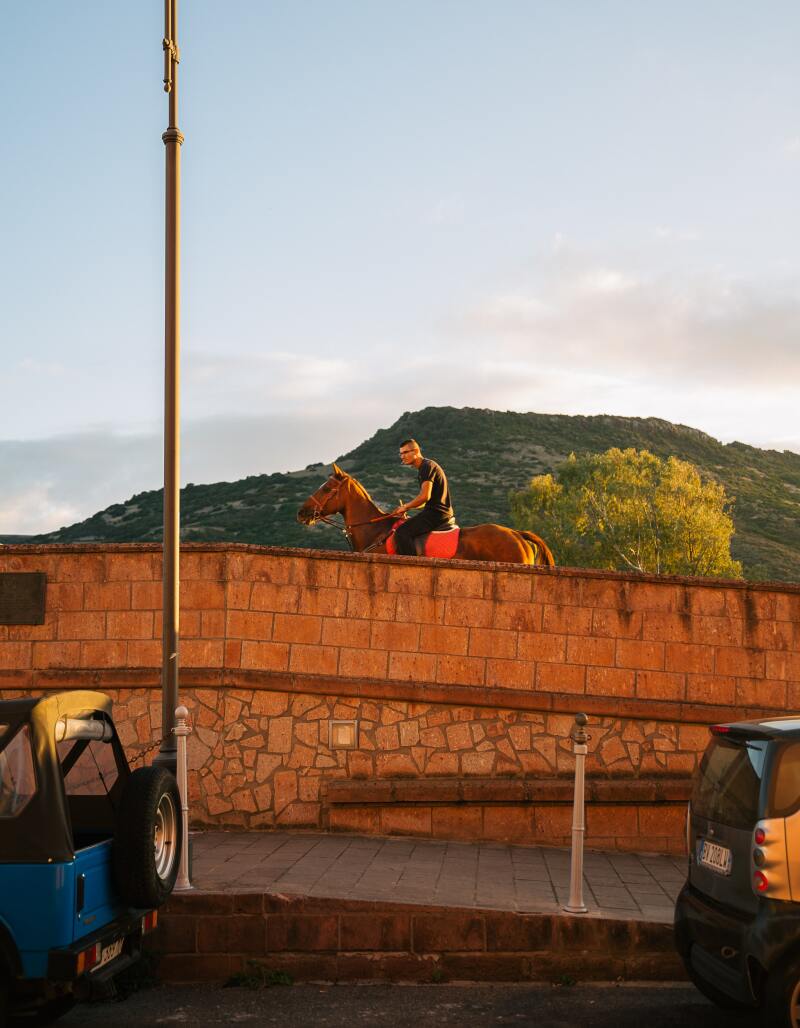
A man travels through a city center on horseback.
Photo by Alex Cretey Systermans
Opening night had that opening-night feel: theater lobby abuzz, men in slacks checking their watches, the occasional performer’s head peeking out for a giddy glimpse of the crowd. At 9 we were led down a long hallway and not into the house seats but backstage, behind the curtain. Our tickets were designed to resemble passports. Migrants are travelers, D’Agostino says.
For the next hour and a half, an abstract, Felliniesque saga played out on the floorboards. The performers, on their backstage set, started out in a violently pitching boat, clutching the sides, clutching at each other. After a harrowing crossing, they were rescued and plunged immediately into the Italian phase of their journey. The story grew more impressionistic here. A Chinese woman sang a sad Sardinian song. A child danced. Midway through, the entire production changed venue, the performers migrating from backstage to the front, and the audience taking seats in the theater, a crossing over.
I couldn’t take my eyes off Baldeh. He had no lines. He didn’t sing. But he was captivating, full of joy and energy and performing these insane high kicks, even while playing his sax. (He had switched recently from trumpet.) Just 362 days ago (no migrant forgets the date, he’d told me), this kid had nothing. Now he was bouncing around a fancy theater packed with Sardinians contemplating an esoteric art piece.
Was the performance good? Was it great art? I don’t know! It turns out my ability to evaluate avant-garde dance/music/live music/speaking/creating situations is limited. Here’s what I do know: An auditorium full of Sardinians sat there thinking of Baldeh not as a lost soul on a raft, or an interloper who might take their jobs, but an energetic musician who can’t keep his feet on the ground. That alone was worth the price of admission.
When the show ended, a small mob rushed the stage. The performers were dazed and euphoric. They accepted our congratulations with a kind of delirious modesty, glancing at each other from across conversations, sneaking grins.
I looked around for Baldeh, but he’d slipped out the back. Tomorrow the cast would head north for a show in Nuoro. He hadn’t exactly said the show might be his big break, but he allowed himself to wonder whom he might meet on the road and where that might lead his musical career. His life is not what he imagined, but it’s here, and it’s ahead of him, and he’s Sardinian now.
>>Next: 8 Surreal Photos That Showcase the Dreams and Fears of Refugee Children











